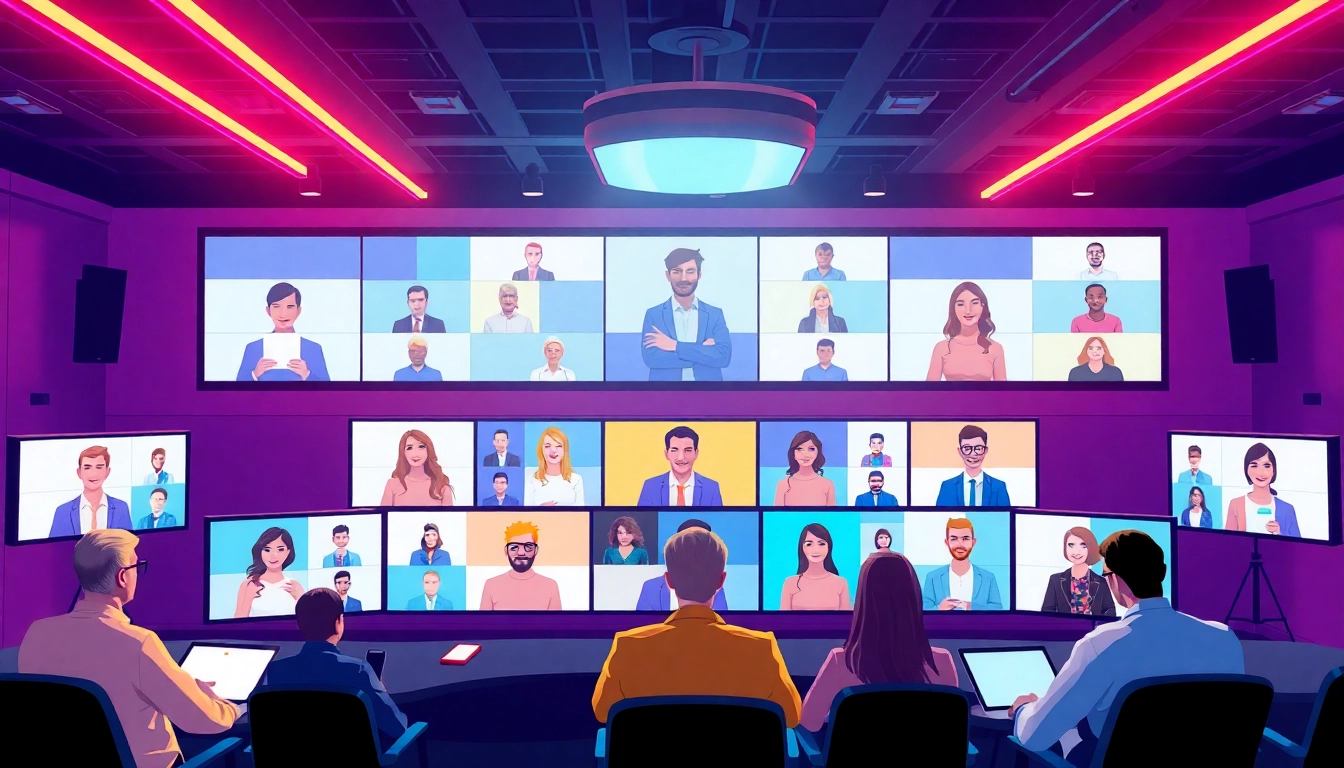
Understanding the Virtual Audience System
What is a Virtual Audience System?
A Virtual Audience System (VAS) is a technological framework designed to facilitate interactions between event hosts and attendees in an online environment. It bridges the gap created by physical distance, permitting engagement that mimics face-to-face interactions. Essentially, it provides tools for communication, feedback collection, and content dissemination in real-time scenarios, significantly enhancing the experience of participants in virtual events. With the evolution of digital communication, a virtual audience system has become vital, enabling event organizers to create immersive experiences typically reserved for physical gatherings. Virtual Audience Systems have evolved to embrace advancements in technology, ensuring that they not only support traditional webinars but also foster engaging, participatory experiences. This evolution reflects a growing awareness of the unique dynamics of virtual environments, where audience interaction is not just encouraged but is essential for success.
Key Features of Virtual Audience Systems
Virtual Audience Systems come with a myriad of features designed to boost engagement and facilitate seamless interaction. These features include:
- Live Polling and Surveys: Allowing real-time feedback and audience participation ensures that the audience feels involved in the session.
- Chat Functions: Providing a platform for attendees to ask questions and engage with speakers enhances interactivity.
- Breakout Rooms: Enabling smaller group discussions encourages networking and detailed conversation on specific topics.
- Content Sharing: Hosts can share presentations, videos, and documents, ensuring visual engagement that complements spoken content.
- Analytics and Reporting: Post-event analysis tools offer insights into participation levels, audience engagement, and preferences, guiding future events.
These features converge to create an immersive experience that can transform a mundane presentation into an engaging event, fostering a community-like atmosphere even in a digital realm.
Benefits for Online Event Creators
The adoption of a Virtual Audience System brings multifaceted benefits for online event creators:
- Wider Reach: A virtual setup permits creators to reach global audiences without the constraints of physical locations, significantly increasing attendance.
- Cost Efficiency: Eliminates the need for venue rentals and travel expenses, allowing budgets to be allocated more effectively towards enhancing the content and experience.
- Data-Driven Decisions: The analytical tools available with most VAS allow creators to gather valuable data on audience preferences and engagement levels, informing future planning.
- Flexibility and Accessibility: Virtual systems accommodate various participant needs, offering options such as recorded sessions for those who cannot attend live.
- Increased Interaction: Engaging features lead to more dynamic interactions, resulting in heightened interest and satisfaction levels among attendees.
Creating Impactful Event Experiences
How to Design Engaging Content with a Virtual Audience System
Creating impactful content in an online setting involves understanding the audience’s needs and preferences. A well-designed virtual experience should consider the following:
- Know Your Audience: Prior to the event, segment your audience to tailor content that resonates with their interests and needs. Understanding demographics, professional backgrounds, and previous event feedback can inform your content creation.
- Clear Objectives: Establish clear goals for content delivery, whether it’s educating, entertaining, or inspiring your audience. Each piece of content should align with these objectives to maintain focus.
- Visual Appeal: Use high-quality visuals and graphic elements in presentations to maintain engagement. Engaging visuals capture attention far more than text sentences alone.
- Storytelling Techniques: Craft your presentations like narratives, weaving in stories that evoke emotion and create a deeper connection with your audience.
By meticulously curating content with these strategies, event creators can significantly enhance the participant experience, driving higher levels of engagement throughout the event.
Incorporating Interactive Elements
Incorporating interactive elements within virtual events can amplify engagement and participation. Here are several approaches:
- Live Q&A Sessions: Opening the floor for questions in real-time fosters dialogue and allows for deeper insights.
- Gamification: Introducing game-like elements such as quizzes and challenges can increase engagement levels. Awards or incentives can stimulate participants’ enthusiasm.
- Interactive Workshops: Encourage hands-on participation through workshops where attendees can apply knowledge immediately. This active participation helps reinforce learning.
- Visual Feedback Tools: Use emoticons or thumbs-up/thumbs-down features to provide real-time feedback on content sections, helping presenters gauge audience reactions instantly.
These interactive elements cater to varying participant preferences and can lead to a more dynamic and memorable experience, ultimately enhancing overall satisfaction with your virtual event.
Analyzing Audience Feedback for Continuous Improvement
Continuous improvement hinges on the ability to analyze audience feedback effectively. Implementing meticulous feedback mechanisms and using analytical insights can drive significant enhancements in future events:
- Post-Event Surveys: Utilize surveys to gather quantitative and qualitative data on attendee experiences. Include open-ended questions for in-depth insights.
- Engagement Metrics: Examine interaction levels during the event, such as participation in polls, chat activity, and session attendance versus drop-off rates.
- Session Ratings: Allow attendees to rate sessions and give feedback immediately following each segment to gather real-time data about content effectiveness.
- Regular Review Meetings: Conduct discussions with the event team post-event to evaluate what worked well and what could be improved, based on the data gathered.
By diligently analyzing this feedback, event creators can implement actionable changes, tailoring future events to suit the audience’s evolving preferences and expectations.
Common Challenges and Solutions
Technical Difficulties with Virtual Audience Systems
Despite their numerous benefits, Virtual Audience Systems are not without challenges, particularly concerning technical issues. Common problems include connectivity failures, software glitches, and user compatibility with platforms. Solutions include:
- Thorough Testing: Conduct a full rehearsal of technical components prior to the event. This should include all possible interactions, scenarios, and backups.
- Technical Support Teams: Have IT support available live during the event to address issues in real-time, minimizing disruption to attendees.
- User Orientation Programs: Offer tutorials or orientation sessions ahead of your event, helping participants familiarize themselves with the technology.
These proactive measures can help mitigate technical difficulties, ensuring a smoother experience for both hosts and audiences alike.
Maintaining Audience Engagement
Engagement is pivotal in online events, yet maintaining it can be a substantial challenge due to distractions in participants’ environments. To cultivate sustained interest, consider the following strategies:
- Dynamic Presentations: Change speakers often to maintain freshness. Utilize varied presentation styles to keep the audience engaged and alert.
- Frequent Breaks: Schedule regular breaks to prevent fatigue and give attendees time to process information. This not only rejuvenates the audience but allows for informal networking.
- Social Media Integration: Leverage social media engagement during events by creating event-specific hashtags, encouraging attendees to share their experiences.
- Regular Check-Ins: Use informal “temperature checks” during the event, asking participants to share thoughts or feelings about the content as it progresses.
Implementing these techniques helps foster a sense of community and participation that can bridge the gap of physical separation inherent in virtual events.
Addressing Privacy and Security Concerns
With the rise of virtual interactions comes an increased focus on privacy and security. Attendees are more aware than ever of the potential risks associated with sharing personal information online. To address these concerns:
- Clear Privacy Policies: Ensure that your audience understands how their information will be used. Share privacy policies in transparent and accessible formats.
- Secure Platforms: Utilize robust security protocols, including encryption and secure servers, to protect user data.
- Participant Anonymity: Allow anonymous participation options in polls and surveys to make attendees feel more comfortable engaging without revealing personal information.
By prioritizing privacy and security, event creators can build trust and foster a safer environment for audiences joining virtually.
Case Studies: Success Stories
Event A: Transforming Attendee Interaction
One notable case involved an annual tech conference that transitioned to a completely virtual format amid recent global events. By implementing a VAS with interactive polling, breakout rooms, and live Q&A sessions, the organizers noted a significant increase in audience interaction compared to the traditional in-person format. Participants reported feeling more empowered to voice their opinions and engage with speakers, showcasing how a thoughtfully designed virtual solution can radically transform attendee experiences.
Event B: Leveraging Data from a Virtual Audience System
A multinational corporation hosted a virtual training seminar for its employees using a VAS equipped with comprehensive analytics. Through data on engagement metrics, the company identified areas where participants struggled. The analysis led to tailored content changes that increased understanding and retention rates in subsequent sessions by over 30%. This case illustrates the invaluable role of data in optimizing events and enhancing participant learning outcomes.
Event C: Innovative Uses Beyond Traditional Platforms
A music festival organized a virtual edition, incorporating augmented reality elements and live-streamed performances using a robust VAS. Attendees could interact virtually with performers and each other, enjoying a festival experience from home. This innovative use of technology not only expanded the reach of the festival but also created unique engagement opportunities, showcasing the versatility and potential of virtual formats beyond traditional conferencing.
Future Trends in Virtual Audience Technology
Emerging Technologies Supporting Virtual Audience Systems
The landscape of virtual audience systems is ever-evolving, with emerging technologies set to further enhance event experiences. Developments in areas such as:
- Artificial Intelligence: AI can personalize audience experiences through tailored content recommendations and interactive chatbots for real-time queries.
- Virtual Reality (VR): VR technologies can create hyper-realistic environments that transport attendees into immersive spaces, enhancing engagement.
- Augmented Reality (AR): AR can overlay additional digital content in attendees’ real-world environments, enriching the information presented.
By integrating these technologies, the capabilities of virtual audience systems will expand, providing richer, more engaging experiences.
Predictions for Online Event Evolution
As technology advances, predictions for online events include a greater focus on hybrid experiences, merging in-person and virtual formats seamlessly. Organizers will likely adopt more adaptive systems that cater to both audiences, enabling them to experience events together, irrespective of their location. Future VAS will enable richer interactions through advanced features that cater to diverse audience needs, encouraging longer participation and greater satisfaction.
Preparing for the Future of Virtual Engagement
To prepare for upcoming trends, event creators should remain proactive by:
- Investing in Technology: Ensure that the tools and platforms used are advanced enough to accommodate future innovations and audience needs.
- Continuous Training: Regularly train team members on new technologies and engagement strategies to maintain a competitive edge.
- Community Building: Focus on building robust communities around events to enhance loyalty and increase future participation rates.
By taking these steps, organizations can position themselves at the forefront of virtual audience engagement, ready to adapt to changes and thrive in the evolving digital landscape.





